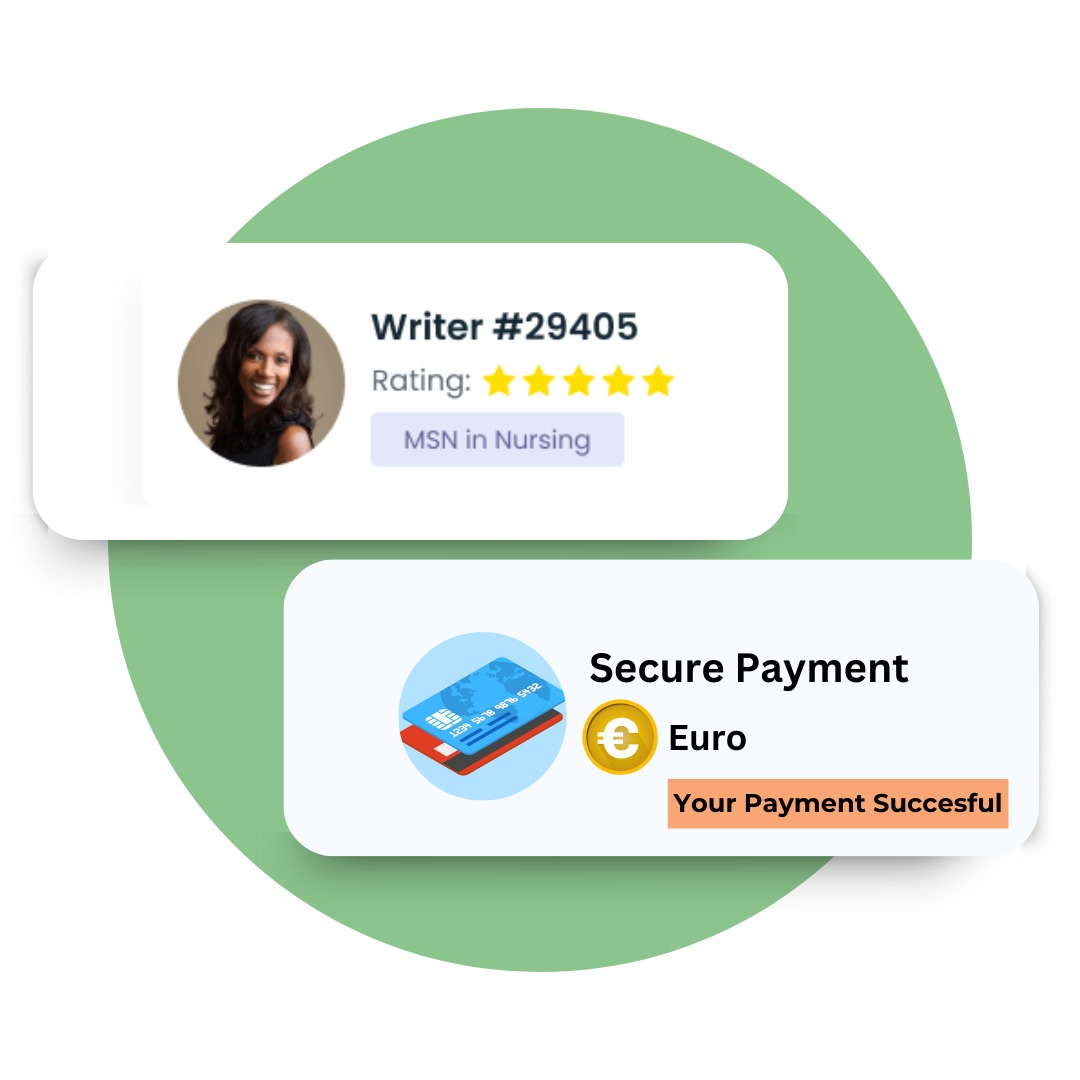Follow these three easy and simple steps to get high-quality assignments at an affordable price.

The order form must be completed and submitted in order to hire the diversity and inclusion assignment assistants. Your order will be sent to the most qualified writer as soon as we get it.

We will provide you with a quote after we receive the order form. After that, you can use online banking, PayPal, or a debit or credit card to make a payment.

After the money has been verified, our assignment writer will go to work on it and finish it by the deadline. From the email, you may download the assignment.
We respect your privacy. All your personal and assignment information will be kept secret and confidential, and for the security of your details, we follow protocols on data security. We will never share your identity or details of your assignment with any third party.
We give you free unlimited revisions for a lifetime for complete satisfaction. Whether you need small tweaks or big changes, we are committed to reworking until it will meet your satisfaction.
Deadlines are paramount, and we ensure proper deadlines for delivery of your diversity and inclusion assignments, even for urgent requests. We ensure you receive your assignments before the deadline, which will give you enough time to study them.
We stringently comply with your stated guidelines and formatting requirements to ensure that your assignment is perfectly comprehensive and written according to the guidelines of your university.
We offer personalized assignment writing assistance to students seeking professional help. We employ a team of skilled professionals from around the globe dedicated to helping with academic tasks. We provide CIPD level 5 assignments for purchase to students seeking CIPD assignment assistance.
Our team consists of specialists in various academic areas, ensuring prompt exam help. You can also access our essay writing service in the UAE, where we have skilled writers dedicated to writing essays on various subjects and topics available for your assistance.
Diversity and inclusion add much value to employees, customers, and broader stakeholders in an organisation. For employees, an inclusive environment increases a sense of belonging and supports diverse perspectives that lead to greater job satisfaction, collaboration, and innovation. Diverse teams ensure better customer service and satisfaction for customers because the likely understanding of varied consumer needs is addressed through diverse teams.
Diversity and inclusion enhance the reputation of the organization among wider stakeholders, such as investors and communities, while ensuring sustainable growth through evidence of social responsibility, thereby creating a more preferable and ethical business partner. Overall, supporting diversity and inclusion helps build organisational resilience and competitive strength.
The legal diversity and inclusion framework ensures a fair, equal opportunity, and safe workplace across work premises and society. The main components are:
Anti-Discrimination Acts: These form the main act through which protection against discrimination is provided. Such acts include age, gender, race, and disability discrimination (for instance, the Equality Act of 2010 in the UK, and the Civil Rights Act of 1964 in the U.S.).
Equal Opportunities and Equality Act: this act provides equal treatment in hiring and employment towards boosting inclusivity.
Affirmative action: Take proactive measures toward helping the underrepresented groups in recruitment and advancement.
Reasonable accommodations: Accommodate disabled persons so that they can perform full potential. (e.g., ADA in the U.S.).
Anti-harassment policies: Prevent harassment on protected characteristics so that the environment is respectful.
Compliance and reporting: Diversity compliance is monitored, reported, and dealt with consequences in case of a breach.
Reaching out toward real diversity and inclusion within organisations remains challenging because several barriers cause setbacks in this quest. Such barriers range from structural to cultural and individual ones that handicap efforts toward an inclusive and diversified workforce.
Start by undertaking an organisational review to increase diversity and inclusion in the organization. Review existing policies, practices, and workplace culture to find gaps that underlie a lack of diversity and inclusions. Seek feedback from employees to understand their experiences and barriers against their having equal opportunities.
Analyse recruitment, retention, and promotion data to search for trends and possible biasing discrimination. Set precise diversity objectives and review policies to put in place the plans with relevant targeted training. Diverse leadership and support for employee resource groups should be created, with regular reviews of progress that will show continuous improvement in diversity and inclusion.
For instance, an Equality Impact Assessment identifies and analyses any foreseeable disproportionate effects a policy, project, or decision is likely to have on protected individuals or groups so that equality legislation is complied with. In so doing, via assessment about age, disability, race, gender, and religion, for instance, an EqIA brings a spotlight on areas unwittingly detrimental to certain groups. And by so doing, adjustments might then be made to have more inclusivity and equity while countering unfair discrimination by most people.
To further increase diversity and inclusion in company policies, the following can be implemented:
Many organizations view the roles played by managers and leaders as being of great importance to the achievement of a diverse and inclusive organizational culture. Leaders set visions toward inclusiveness, allocate resources, and adopt policies that support fair hiring, equal opportunities, and zero-tolerance non-discrimination. In them, the tone at the top can be communicated as an issue of importance in showing diversity.
Managers interpret these policies into daily action on the operational level while ensuring they are being implemented. They create safe environments for open dialogue, encourage diverse hiring, and address issues directly within their teams. Leaders not only show accountability but also promote respect; they also offer growth opportunities toward building a culture that sees each employee as valued and included.
Diversity and Inclusion Training: Forcing diversity training that explains issues such as unconscious bias, cultural sensitivity, and the benefits of a diversified workforce.
Educational Seminars and Workshops: An educational workshop or seminar that creates awareness among employees regarding other cultures, identities, and perspectives will melt related stereotyping and create awareness.
Design a recruitment process to reach a diverse pool of candidates. This can be through blind recruitment methods or association with organizations promoting diversity in hiring.
Supportive Work Policies: Accommodate different cultural, religious, and personal needs. This can range from flexible working hours, holiday accommodations, and parental leave policies that support all forms of family structures.
Cultural Celebrations and Events: Organize activities or events that celebrate various cultural festivals, days of awareness, and holidays (Pride Month, International Women’s Day, Black History Month) to increase visibility and attention to different groups.
Employee Resource Groups: Offer support for employees to form ERGs based on interest, backgrounds, or identities to enable more employees to connect and share experiences that drive initiatives supporting diversity and inclusion.
Inclusive Leadership: Leaders have to follow the above practice of being an inclusive leader by exhibiting open communication, access, and attentive hearing from all employees coming from diverse backgrounds.
Channels for Regular Feedback: Allow all staff access to the safety of reporting issues or ideas about diversity and inclusion using anonymous surveys or focus groups.
Mentorship Programs: Create or design mentorship programs that will sponsor groups of employees from diverse backgrounds who can be led or mentored by senior leaders. This will promote career advancement for the underrepresented groups within the organization.
Leadership Diversity: Expand on the representation of diverse members in leadership teams and decision-making bodies. Representation at all levels of the organization ensures that there are diverse views included in key decisions.
Accessibility: Accessibility of the physical and digital space to the employees with disabilities.
Office space, remote locations, and assistive technologies are taken into account as well.
Inclusive language and imagery: Communications and marketing materials to and fro, internal communications, website content, avoid stereotypes, and a rainbow of people in imagery
Cultivate alliances with organizations that advocate for or serve underrepresented groups. Such alliances could be collaborations on community outreach programs, educational programs, or advocacy initiatives.
Social Responsibility Initiatives: Engage your workforce in a host of social responsibility efforts focused on issues related to diversity and inclusion by working with local charities, supporting marginalized communities, or contributing towards relevant causes.
Consider the following methods in measuring and monitoring the influence of a diverse and inclusive organisational culture:
Hear how we have helped our students with their assignments in diversity and inclusion.
A
Aisha Rahman

I was struggling with my CIPD Level 5 case study, but the team at cipdassignmenthelper.ae provided invaluable assistance. Their expert insights and structured approach helped me achieve a high grade. I couldn’t have done it without their support!
M
Mohammed Zayed

The support I received for my CIPD Level 5 assignments was exceptional! The writers understood the requirements perfectly and delivered work that exceeded my expectations. I felt confident submitting my essays, knowing they were top-notch.
M
Mansoor Ali

I was struggling with some CIPD Level 5 concepts at London American City College, but the CIPD Assignment Helper clarified everything. Their assignments are detailed and thorough, and my confidence has skyrocketed!
A
Asma

The experts at CIPD Assignment Helper were friendly and knowledgeable. Studying CIPD Level 5 at the University of Wollongong in Dubai is tough, but their support helped me stay on track and succeed in my assignments.
H
Hassan Raheem

Studying CIPD at Blue Ocean Academy in Dubai is demanding, but CIPD Assignment Helpers made it so much easier. They handled my CIPD Level 5 assignments professionally and provided the best assignments that made me stress-free of assignments.
Z
Zayed Hussain

CIPD Assignment Helper is a budget-friendly option for my CIPD Level 5 assignments. The quality they give for the price is unbeatable. I got excellent grades and I’ll use them again.
Our specialists are ready to help you tackle any assignment. Sign up for expert support today!
